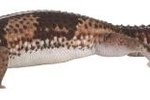
Metamorphosis is a bit like a teenage stage for a frog. He is growing fast, and that makes him a little awkward. He runs a higher risk of getting eaten because his growing legs don’t let him swim the way he’s used to. He develops back legs first because they're more streamlined than his front legs. He develops front legs next, and then his tail is absorbed. The length of time metamorphosis takes depends on the tadpole’s species and environment.
Metamorphosis Trigger
Before a tadpole can transform into an adult frog, he has to grow larger. Once he reaches the ideal size, his thyroid begins producing a hormone that triggers metamorphosis. If life in his watery world becomes too dangerous, the thyroid may begin producing the hormone early to help him transition to land and escape the water. This can occur if too many tadpoles congregate in one spot, more predators than usual are lurking around, food is harder to find or the water is drying up.
Back Legs
A tadpole’s back legs begin to emerge after he reaches the ideal size. The back legs appear first as tiny limb buds at the base of his tail and eventually grow into very large legs. He keeps them folded against his body while they're growing. With his legs tucked up under his round belly, he's able to swim without being slowed down too much.
Front Legs
The front legs develop inside the gill pocket of the tadpole’s body. They don't emerge until he's almost ready to leave the water because they slow him down even more than the back legs. Once all four of his legs have popped out, the tadpole is called a froglet. He must now grow into an adult frog quickly to shorten the amount of time he's in the water with reduced swimming ability.
Tail Loss
After the froglet develops all four legs, he begins to lose his tail through a process called apoptosis. As the tail is slowly reabsorbed into the froglet’s body, he won't eat -- reabsorbing his tail is a bit like eating a big meal, providing nourishment. Once he loses his tail, the frog is ready for life on land. He has powerful back legs for jumping, and his front legs help pad his landing.
References
- Sensory Evolution on the Threshold: Adaptations in Secondarily Aquatic Vertebrates; J. G. M. Thewissen, Sirpa Nummela
- National Center for Biotechnology - Metamorphosis: The Hormonal Reactivation of Development
- The Ecology and Behavior of Amphibians; Kentwood D. Wells
- National Center for Biotechnology - Programmed Cell Death (Apoptosis)
- Herpetology: An Introductory Biology of Amphibians and Reptiles, George R. Zug et al.
Resources
Photo Credits
-
Hemera Technologies/PhotoObjects.net/Getty Images
Writer Bio
Sarah Albert has been a writer and editor since 2003. She produced a workbook for the Shenandoah Women's Center and also enjoys covering animals. Albert holds a B.A. in English and a B.S. in animal behavior.




